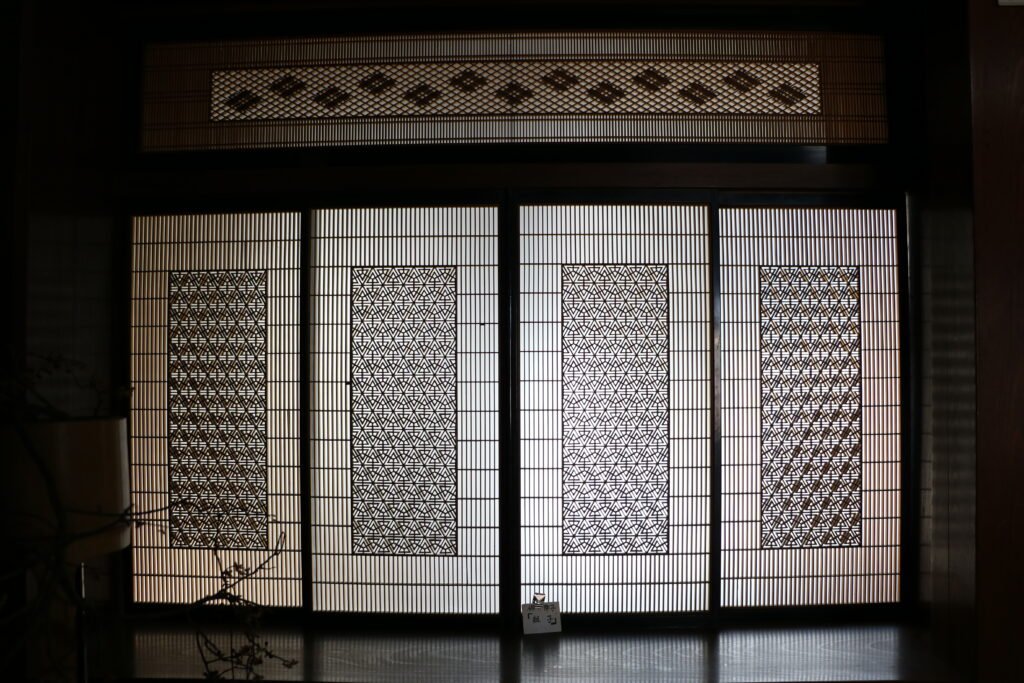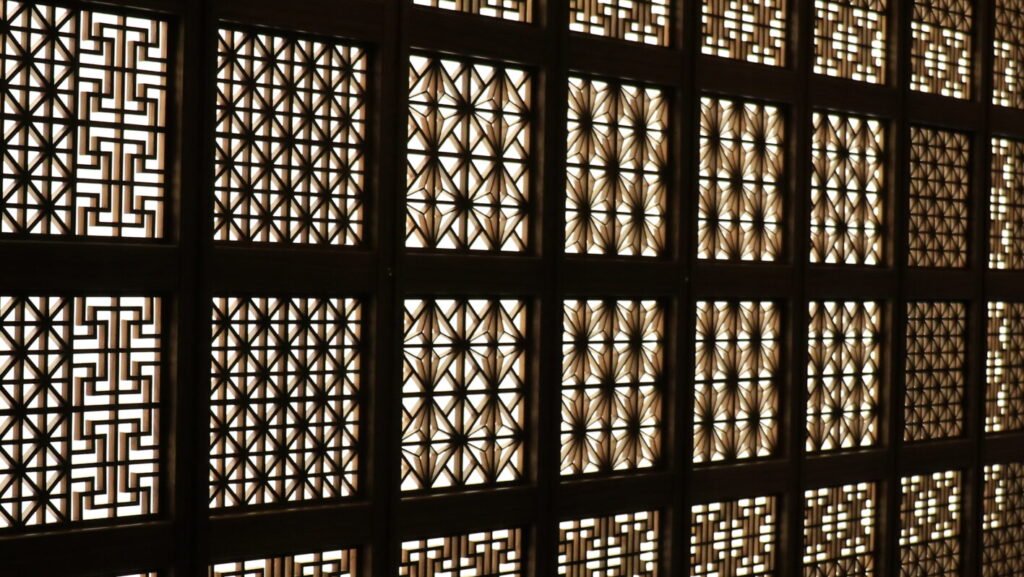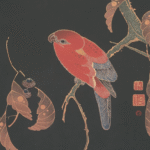We’ve reached the final installment in our series on traditional Japanese Kumiko patterns. Following our previous articles on Hemp Leaf, Diamond and Lattice, and Tortoise Shell and Basketweave patterns, we now explore distinctive motifs and complex designs that symbolically express natural beauty, practical wisdom, and human aspirations.
To View the Complete List of 40 Kumiko Patterns:
The Significance of Distinctive Motifs in Kumiko Patterns
Unlike the geometric basic patterns introduced previously, these Kumiko patterns feature more concrete motifs and complex compositions. From floral elements to designs rooted in Japanese seasonal celebrations, they showcase diverse expressions that evolved from imperial courts and religious buildings during the Nara (710-794) and Heian (794-1185) periods, with further variations emerging in merchant culture during the Edo period (1603-1868).
Distinctive Motif Kumiko Patterns
Mitsugumite (Three-Way Joint)
Mitsugumite is a fundamental Kumiko technique where grooves are cut into slats from three directions and joined together, creating continuous triangular patterns. Considered the core of Kumiko craftsmanship, this technique was once reserved for master craftsmen. The number “3” in Japanese culture represents completeness, while triangles provide both geometric beauty and structural strength. Though appearing simple, mitsugumite requires precise calculations and delicate technique.
Kasane-Rindo (Layered Gentian)
This elegant pattern depicts the autumn gentian flower with overlapping circular layers that combine splendor with refinement. Gentians appear in classical literary works like “The Tale of Genji” and “The Pillow Book,” their vivid purple blossoms and dignified form matching aristocratic aesthetics. The pattern’s continuous circular forms symbolize “good connections” and “human bonds,” making it popular in both traditional and contemporary design contexts.
Rindo (Gentian)
A simpler version of the gentian flower pattern expresses five spreading petals. Historically valued as a medicinal plant for stomach remedies, gentian symbolizes health and longevity. Its flower language includes “sincerity,” “justice,” and “compassion,” with the Kumiko pattern embodying wishes for “sincere hearts” and “healthy living.” When arranged continuously, these patterns create chain-like connections associated with matchmaking.
Goma (Sesame)
Goma presents a linear, dignified pattern modeled after sesame seed cross-sections, characterized by clean right angles. Sesame was historically prized as a “medicine for longevity” and provided essential nutrition and lamp oil. This pattern, also used in formal samurai attire, carries meanings of “longevity,” “health,” and “bright future.” Its geometric beauty resonates with contemporary minimal design and is frequently used in restaurants and tableware.
Kawari-Goma (Modified Sesame)
Kawari-goma adds creative variations to the traditional sesame pattern by altering line thickness and arrangement. This demonstrates Japanese culture’s flexibility in respecting tradition while embracing innovation. When combined, these patterns create unexpected geometric effects that showcase craftsmen’s creativity. Both classical and contemporary, kawari-goma works well in modern Japanese spaces from residences to commercial venues.
Ura-Goma (Reverse Sesame)
Ura-goma further varies the sesame pattern with an inverted composition that creates deeper visual complexity. Connected to the Saga Nabeshima clan and used in formal samurai attire, this pattern reveals complex geometric designs when pieces are arranged continuously. Maintaining sesame’s symbolism while providing refined impressions, ura-goma exemplifies how traditional Kumiko patterns can feel simultaneously historical and contemporary.
Sakura (Cherry Blossom)
Cherry blossom Kumiko patterns geometrically represent five petals and central stamens, symbolizing Japanese spring. Sakura holds such cultural significance that the word “flower” alone traditionally referred to cherry blossoms. This pattern celebrates spring’s arrival, wishes for harvests and prosperity, and new beginnings. The five petals reference the “five grains” and “five blessings,” making it an auspicious design that adapts beautifully to contemporary spaces.
Mikado-Tsunagi (Imperial Connection)
This complex pattern features continuously spreading polygons resembling a kaleidoscope. Named for its imperial associations, mikado-tsunagi combines triangles and diamonds to symbolize “prosperity,” “eternal life,” and “stability.” The continuous geometric designs express wishes for uninterrupted prosperity, while evoking cosmic order and harmony. Requiring advanced calculations, this pattern represents the pinnacle of Kumiko craftsmanship.
Seigaiha (Blue Ocean Waves)
Seigaiha depicts waves through overlapping semicircles, symbolizing endless ocean expanses. Possibly derived from Heian period court music or folding fan shapes, this pattern carries wishes for “eternal peaceful living” and “expanding happiness.” Used in traditional textiles and family crests, wave motifs hold special significance in island-nation Japan. Today, seigaiha appears in restaurants, inns, and spas, maintaining its timeless popularity.
Masu-Tsunagi (Connected Squares)
Featuring continuous square measuring box shapes, masu-tsunagi was popular on festival clothing from the Edo through Taisho periods. The “masu” (measure) symbolizes accuracy and fairness, while phonetically connecting to “increase” (増す), suggesting growing fortune. Inside simple squares, more complex joinery creates depth despite apparent simplicity. Its geometric beauty and auspicious meanings find applications in modern interiors, fashion, and graphic design.
Fundo-Wa-Tsunagi (Weight-Ring Connection)
This pattern depicts “fundo” weights (used for measuring precious metals) connected by rings. Ancient weights had distinctive circular forms with side indentations, symbolizing wealth and good fortune. The connecting rings add meanings of “harmony” and “connection,” making the pattern especially popular among merchants for business prosperity. Its unique blend of curves and straight lines creates both softness and strength, working well in contemporary Japanese-inspired designs.
Contemporary Value of Kumiko Patterns
These distinctive Kumiko patterns possess cultural and spiritual value beyond decoration. Originating from nature, daily life, and beliefs, they embody Japanese aesthetic sensibilities and universal wishes that transcend time. Contemporary designers integrate these patterns into architecture, interiors, product design, and graphics, particularly within “modern Japanese style” concepts.
In today’s sustainability-focused world, the Kumiko technique—using no nails or metal fittings—attracts attention as an environmentally friendly craft. The artisanal warmth and precision of these patterns appeal to those seeking authenticity beyond mass production. The universal wishes embedded in Kumiko patterns—longevity, prosperity, happiness, harmony—resonate across cultures, explaining their enduring appeal.
Our series exploring 40 Kumiko patterns concludes with these distinctive motifs and combinations. These patterns represent not merely decorative techniques but cultural expressions that continue inspiring contemporary designers worldwide. By understanding their historical backgrounds and symbolic meanings, designers can create works with greater depth.
Kumiko patterns bridge tradition and innovation, connecting past and future through woodworking mastery. Their extraordinary marriage of function, beauty, and meaning exemplifies Japanese craftsmanship’s finest qualities. As modern design increasingly values authenticity and sustainability, these patterns offer valuable lessons in patience, material harmony, and intentional creation.
Whether in architecture, furniture, or decorative objects, Kumiko patterns continue evolving while maintaining their essential character—demonstrating how tradition remains vibrant when treated as a living language capable of speaking to each new generation.

“Kumiko Patterns: Tradition and Symbolism” Series
This “Kumiko Patterns: Tradition and Symbolism” series will be published in four consecutive installments. If you’re intrigued by these traditional Japanese wooden lattice designs and their cultural meanings, we invite you to explore each article through the links below as they become available. Each installment delves deeply into one category, revealing the historical context, symbolic significance, and contemporary applications of these remarkable patterns.
- Kumiko Patterns: Tradition and Symbolism Part.1 – The Sacred Geometry of Hemp Leaf Designs
- Kumiko Patterns: Tradition and Symbolism Part.2 – Diamond and Lattice Structures
- Kumiko Patterns: Tradition and Symbolism Part.3 – Tortoise Shell and Basketweave Artistry
- Kumiko Patterns: Tradition and Symbolism Part.4 – Distinctive Motifs and Combination Masterpieces
Thank you 🙂



